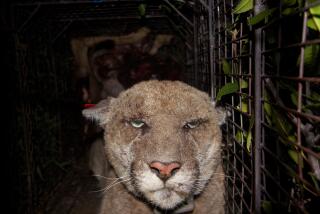Get the lead out
BACK IN THE good old Pleistocene Epoch, California condors sailed over the heads of sloths and saber-toothed cats, keeping an eye out for the tasty carcass of a mastodon. Eating the prehistoric version of fast food, they survived to the present day while those other species went extinct.
Now, however, they face extinction -- there are only about 100 wild condors in California and Arizona (and that’s up from 22 in 1987, when the last wild one was rounded up for a captive breeding program that has cost $40 million so far). By banning some hunters from using lead ammunition, California can help the condor survive.
Despite their remarkably long-lived story, condors have problems surviving near humans. They fly into power lines, eat any small and shiny but possibly toxic object, drink antifreeze and like to hover around bustling activity. They don’t produce enough eggs to overcome population losses, and they lack the ability to rid themselves of the toxic bits that get lodged in their gizzards.
That’s why lead is one of the biggest threats to the condor. Lead pellets from ammunition, which the condors can ingest when they eat the remains of hunted animals, stay in their bodies while their acidic digestive system slowly dissolves the toxic metal. There are other sources of lead in the condor environment. But evidence is building that ammunition is a leading culprit, and environmentalists have sued the state to prohibit its use. Now the state Department of Fish and Game is planning to propose a ban on lead ammunition for big-game hunting -- in condor territory if not statewide -- to the state Fish and Game Commission.
Lead bullets already are banned in federal waterways. A private contractor is ridding Santa Cruz Island of its wild pigs using non-lead ammunition because federal officials want to avoid contaminating the island. The change would require some sacrifice from hunters. Copper or other non-lead bullets cost more than regular ammunition, but not much more: For the average hunter, it would cost an extra $50 to $70 a year.
Hearings on the proposal begin in February, and the commission should take action before the courts do. If, after several years, the change hasn’t improved the condors’ lot, hunters will have their own ammunition to argue for an end to the ban -- and wildlife experts will be left to find other ways to save the largest bird in North America.
More to Read
Sign up for Essential California
The most important California stories and recommendations in your inbox every morning.
You may occasionally receive promotional content from the Los Angeles Times.










